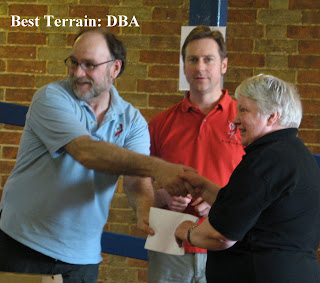Thankfully, I forgot to take my camera to Partizan ... so showteamer, Chris, made sure he got some pictures for us with his camera (which is better than mine!)... Excellent.
For Partizan, we returned to the Poitiers theme, and my developing DBA scenario.... 'Froissart's Poitiers' (so styled, because it features a really significant hedge and ridge - just as Froissart describes)...

Basically, the game is a part-way DBA Big Battle ... the English have a standard DBA army, but a position magnifique (to borrow, appropriately enough, from the French ...).. The French have 2 DBA army sized battles (+ the Marshals as supernumerary elements not counting for losses ..).. representing the first and third parts of the army... with which to assault it.

The whole of the French army is deployed on foot, with the exception of the two Marshals of France, Clermont and D'Audrehem. The Black Prince is provided with a foot or mounted element, and chooses which to be when he first moves in the game. The second French Battle commanded by the Duc D'Orleans did not participate in an organised way, so is not represented.
I will include a full scenario when the experience of a few more shows has refined it down - fighting two battles (in both senses, really) is a precarious balance ... it makes the game take longer than DBA really should ... but most of the teams presenting games at the battleday seemed to reckon this was the most legible way to do Poitiers...

This shows me removing the defeated Prince of Wales from the first game of the day (losing all ends up to a red hot youngster - becoming a speciality of mine, it seems). Aficionados of the game will well understand that once in combat, you might get overlapped, and an overlapped Knight General can end up fighting on a 3 against an overlapped Blade on a 2. This creates that situation where the battle can be immediately lost if you roll 1 and the youngster rolls a 6. There is a rule of wargaming which predicts this will always happen.
The pictures show the first evolution of my new terrain, replacing the commercially pre-flocked boards we used at Triples earlier in the year. It was a partial success. I have tried to copy Mark Craddock's 'rolling foam' idea which looked so good at the Society of Ancients Battleday (remember these ...) ... but my colouring was far less lush, and my foam was lifting a bit at the edges .... Version 2 will be much better!

The whole thing was constructed inside a pasting table (so folds out quickly when arriving at a show ...) and was the right shape for the battlefield once I switched the hinges around. I think it's a good idea, and I love the way it folds away to go back in the car (no more bits of broken polystyrene!)... but this is just the first go at it ...
Returning to the scenario, I've dealt with the Captal de Buch's outflanking manoeuvre by borrowing some bits from HOTT: if the English roll a 6, they can use it to allow the Captal and his detachment to slip away from view (behind the hill, as it was, historically) ... if/when another 6 is rolled, the concealed force may reappear anywhere on the table edge. This has worked very smoothly to allow the English their outflanking stratagem.
But overall, did the hugely advantageous English position allow them to survive having to fight two French armies, one after the other?

Well, we played through 4 times ... and given my excellent combat skills when taking the English army (charging the Prince of wales in, and rolling' one's!), there were 2 French wins and 2 English. Perfectly balanced, but more by incompetence than actual design, maybe. Of course, historically, the English win ... and then some...
Ah well.
Thanks to the Newark Irregulars for their hospitality, and to Dave Lanchester of the Lance & Longbow Society (with who we team up for this show - and who is very forgiving of my idiosyncrasies!)... Thanks to the players for making it fun.
We will be in Birmingham next weekend, at the UK Games Expo... We don't have a full 'wargame' space, but I will take along Gladiolus and some of the other SoA games (if anyone wants to try them out). I would love to hear from Society of Ancients members who might be able to lend a hand over the weekend (at the Expo, or any of the scheduled events - we could always do with more). Don't hesitate to get in touch.
(figures in the pictures by Graham Fordham, photos by Chris Ager)

































